page 3
(The Study of Threes)
http://threesology.org
Attributes of the brain hemispheres show a distinctive (but somewhat overlapping) partitioning along a 1-patterned, 2-patterned, 3-patterned formula, with the earlier brain structures exhibiting a smaller numerically identifiable value, just as we find in the development of Primordial Germ Layers to the extent that we humans, as a complex organism, grow from 3 Germ Layers, and less complex organisms grow from fewer than 3 layers. Hence the idea that we grow physiologically along a 1- 2- 3 maturational development sequence.
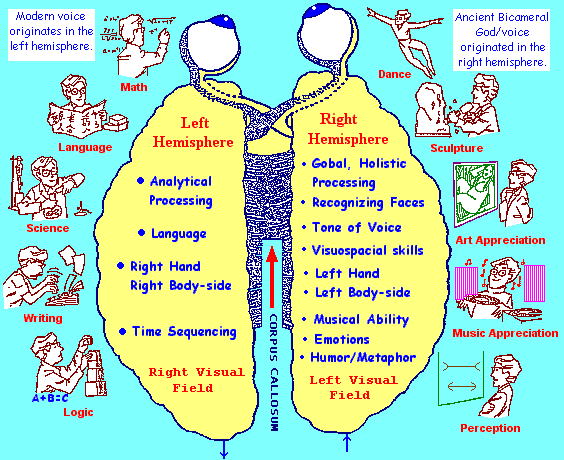
***Note: Much of the brain illustration shown above was adapted from page 106 of Dean Falk's book entitled "Brain Dance," 1992.
When we look at the assigned culturally recognized attributes of the brain, we can see a distinct (over-lapping) 1-patterned, or 2-patterned, or 3-patterned arrangement. (Reminder: when a person gets a stroke in the left hemisphere of the brain it affects the right side of the body, and vice-versa.)
|
Left Hemisphere (Predominantly 3-patterned) Math: Associative Commutative Distributive Logic: Major Premise Minor Premise Conclusion Time Sequencing: Seconds ~ Minutes ~ Hours Past ~ Present ~ Future Day ~ Week ~ Month Language: Subject Object Verb Right Body Side: Tri-cuspid heart valve Three-lobed lung |
Right Hemisphere (Predominantly 2-patterned) Holistic: Macro versus Micro Whole versus Part Inner versus Outer Music: Major Scale vs Minor Scale Loud versus Soft (Quiet) Consonance vs Dissonance Visuospatial: (Art) Background vs Foreground Light vs Dark (Contrasts) 1 Dimension vs 2 Dimensions Emotions: Pain versus Pleasure Positive vs Negative Love versus Hate Left Body Side: Bi-cuspid heart valve Two-lobed lung |
 The correlations of two and three being made on this page are not typical considerations. However, I did come across a single reference concerning the tricuspid valve: http://www.madsci.org/posts/archives/mar97/855255174.An.r.html | |
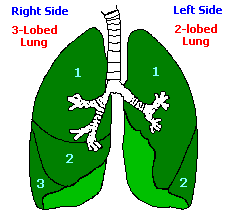 In recognizing that the left lung is smaller than the right lung (which provides room for the heart), let us conjecture that this is due to some past earlier developmental sequence just as we find the 1-layer, 2-layer, 3-layer sequential development of the 3 primordial germ layers (Ectoderm - Mesoderm - Endoderm) in primitive -to- more complex organisms. Hence, difference in size (dimorphism) as well as a two/ or three prominence may provide another link towards understanding developmental processes. Does this mean that the recurring smallness of the female to the male in many species indicates that females came before the male in terms of species-specific evolutionary development during particular environmental circumstances? If so, will there be an increased development towards a 3 to 1 "fusion" ratio? | |
|
(Reptilian) (Predominantly 1-Patterned) (Self)-Preservation~ (Self)-Procreation~ (Self)-Preeminence | |
Some additional two-patterned references found in music:
- Tension and Release
- Staccato and Legato
- Slow and Fast
- Ascending and Descending
An analogy to the 3 brain divisions of Reptilian ~ Neo(New)-Mammalian - Mammalian (or Reptilian - Limbic system - Neo-cortex), can be made with the ancient view of the world once held by Nordic peoples who thought the three roots and three limbs of the Yggdrasil tree held Earth, Hell, and Heaven together. (A 3 into 1 fusion concept.)
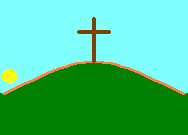
In their own way, it can be imagined, they were (unknowingly) illustrating a fundamental organizational structure of the brain that matures along a 1~ 2~ 3 maturational development sequence, even though the actual influence for the 3 root/3 branch notion of the Yggdrasil tree may have been derived from viewing the Christian cross standing upright to represent the 3 branches and its shadow (during the death of Christ at 3:00 PM) would have given the impression of 3 roots. (The "3 limb" cross upon which Christ is thought by some to have been attached and stuck with a spear, is a theme seen in the story of Odin being attached to the 3 branched Yggdrasil tree and also stuck with a spear.)
Does there exist some underlying three-patterned basic formula which influences humans to organize world views in a three-patterned manner, in singular and multiple representations thereof? And yet we must acknowledge that the 3-patterned formula is part of a larger 1- 2- 3 maturational development circumstance.
For those of you who have a penchant for taking the obvious for granted, please note that the Nordic peoples are part of the Indo-European family, and it is this (3rd born) family, more so than (2nd born) Asians and (1st born) Africans which has the greatest proclivity for developing three-patterned views of the world:
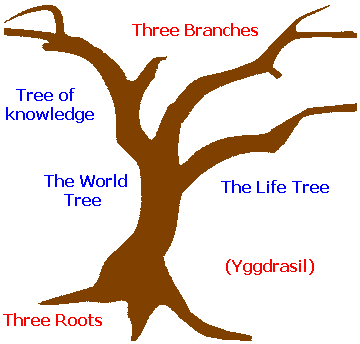
For other variations of the tree see the pages on Linear - Circular - Triangular configurations:
Note: When we use the left hemisphere attribute "analysis" to define qualities of the right hemisphere, we often-times assign an additional third criteria in one form or another. When we use the right hemisphere attribute 'viewing' (recognizing) to define qualities of the left hemisphere, we often-times alter the 3-part descriptions into 2-part 'portraits'. For example, (generally speaking): Left "analyzing" Right: Holistic may acquire the additional term "Synergy" or "Unity"; Music can develop a Triadic structure; Art acquires a 3rd dimension and 3-color (trichromatic) theory; Emotion is assigned words such as Compassion, Patience, and Empathy. Right "viewing" Left: Math may be seen as Give & Take; Logic may become a Mind/Body dichotomy; Time is related to Life & Death; Language is perceived as High & Low pitch. Left "analyzing" Reptilian attributes may develop three criteria which distinguish a (3 in 1) singular nature, such as arousal, motivation, and emotion. Right "viewing" Reptilian attributes may picture the basic drives as the seat of emotion whereby a type of kinship alliance is formulated in order to maintain the idea of a dual brain by not permitting the "Reptilian Brain" a separate entity status. Reptilian "viewing" Right and Left are seen from the perspective of someone with blinders on. |
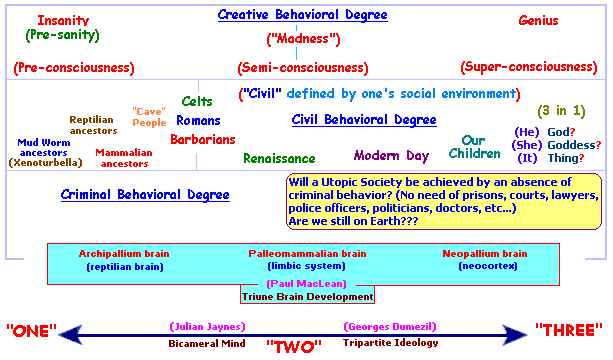
| "THE ONE" (metaphysical attribute) |
(one and many are viewed as opposites) | "THE MANY" (metaphysical attribute) |
| Monistic/"Unitarian" thinking | Dualistic/Polarity thinking | Trilistic/Trichotomous... |
| JEWISH TORAH (reliance on the "one," separateness, uniqueness, "chosen") | OLD BIBLICAL TESTAMENT (increase in two-patterned views) |
NEW BIBLICAL TESTAMENT (increase in three-patterned views such as the many patterns-of-three in the life of Jesus. See: --- Three Wise Men Poem English version ---) |
| Archaic/primitive thought | Post archaic and Middle Ages thought | Post Middle Ages and present thought |
It is of some interest to note that our so-called modern Jurisprudence philosophy, as is practiced in the courtroom by lawyers and judges when questioning witnesses, relies heavily on a two-patterned either/or, this or that, yes or no formula.
One example of a dual brain idea:
| L-mode (Left Brain) | R-mode (Right Brain) |
| L-mode is the "right-handed," (left-hemisphere neo- mammalian) mode. The L is foursquare, upright, sensible, direct, true, hard-edged, unfanciful, forceful. | R-mode is the "left-handed," (right-hemisphere old- mammalian) mode. The R is curvy, flexible, more playful in its unexpected twists and turns, more complex, diagonal, fanciful. |
| Step-by-Step reasoning | Mystical |
| Logical | Musical |
| Mathematical | "Creative" ("Re"- Creative?) |
| Speaking | Visual-pictorial |
| Dominates right brain | Submissive to the left brain |
| Pattern user | Pattern seeker |
| Parallel ways of knowing (J. E. Bogen) | The Duality of Yin and Yang (I Ching) | ||
| Intellect | Intuition | Yin | Yang |
| Convergent | Divergent | Feminine | Masculine |
| Digital | Analogic | Negative | Positive |
| Secondary | Primary | Moon | Sun |
| Abstract | Concrete | Darkness | Light |
| Directed | Free | Yielding | Aggressive |
| Propositional | Imaginative | Left side | Right side |
| Analytic | Relational | Warm | Cold |
| Lineal | Nonlineal | Autumn | Spring |
| Rational | Intuitive | Winter | Summer |
| Sequential | Multiple | Unconscious | Conscious |
| Analytic | Holistic | Right brain | Left brain |
| Objective | Subjective | Emotion | Reason |
| Successive | Simultaneous | ||
The above information has been adapted from:
http://members.ozemail.com.au/~caveman/Creative/Brain/lrbrain.htm
See also:
--- Examples of Right/Left Brain Differences ---
http://www.threesology.org/lr-brain-attributes-1.php
It could be said that the above example(s) are 1 way of looking at 2 divisions of a 3-part structure, even though three parts are not consciously described. An unconscious recognition of a 3rd structure is shown by the fact that the L- and R- mode designations clearly indicate that traits of a 3rd entity herein called the "C- (reptilian brain) mode," are overlapped into the definitions of qualities representing the R and L modes. When it is said that the Left hemisphere exhibits "forceful, direct, even aggressive qualities," it should be considered that these are not actually definitively singular qualities of the L mode, but are traits of the L-mode overlapped with the C-mode attributes. Likewise, when we look at some of the above descriptive terms of the R-mode, it is clear that the word "impulsive" may, in some circumstances, be substituted. "Impulsiveness" clearly is a characteristic many of us would apply to the The "C- (or Center, Reptilian brain) mode," is the "middle-handed" basic (oral ~ anal ~ genital) drives mode. In summation, any of us who would use a two-part structure to define attributes of a 3-part structure, would necessarily overlap, combine, condense, substitute, symbolize, etc., the 3rd part into two structures in some fashion or another, and justify our results with rationalizations we feel are quite credible to a two-patterned perspective.
Unfortunately, those who have a budding three-patterned perspective may be somewhat timid to exert their own views because they can not customarily be substantiated by clear-cut examples representing an intuitive appreciation of a 3-part structure that has no formal socially recognized criteria of acknowledgment, much less acceptance. It is like having an intuitive understanding of riding a bicycle, yet you are unable to convey your appreciation to others who have no concept of a bicycle. Perhaps this analogy will help many of you to appreciate that while more and more people, on an individualized basis, will begin to evolve qualities of perception related to a 3rd consciousness, our education system, our structure of government, and our past religious, philosophical, and metaphysical views are wholly in adequate to help these people in their personalized trek towards a maturing 3rd consciousness. If this maturational process takes place with many individuals in a simultaneous manner, there will be many different types of revolutions taking place in various areas of human concerns. If all these smaller revolts coalesce into a singular movement, all Revolutions that have come before throughout history, will be like a child's afternoon tea- party where cookies and koolaid are served to dolls, stuffed animals, and make-believe companions. In other words, all the conflicts of the past will be seen as nothing more than make-shift dress rehearsals.
3 basic treatment programs of American Prison systems:
- Education
- Medical Care
- Religious practice
3 major objectives for which inmates are allowed to leave the prison:
- Work- (maintain skills)
- Occupational training- (acquire skills)
- Education- (improve present skills, replace outdated skills with marketable skills)
3 year time period used as a measure of evaluation for the recurrence of crime as shown in a report that was prepared for the Bureau of Justice Statistics, the statistical branch of the Justice Department, by Patrick Langan and David Levin. (June 3, 2002):
67 percent of inmates released from state prisons in 1994 committed at least one serious new crime within three years.
272,111 former inmates were examined in 15 states during the first three years after their release.
3 to 1 ratio concerning prisoner recidivism:
1 prior arrest- prisoners have a 40.6 percent recidivism rate three years after being released.
2 prior arrests- prisoners have a 47.5 percent re-arrest rate within three years after being released.
3 prior arrests- prisoners have a 55.2 percent re-arrest rate within three years after being released.
Each additional prior arrest increases the percentage of rearrest rates, reaching a rearrest rate of 82.1 percent for inmates with more than 15 prior arrests.
It is said that the finding about the recidivism rate reaching 67.5 percent in three years is particularly striking because earlier studies, dating to the 1960's, have all found that rearrest rates of American prisoners tend to hover at about two-thirds within the first three years after release.
3 particular crimes compared:
The report found that people who commit crimes involving money are more likely to be rearrested than those committing homicide or rape, with a recidivism rate of 70 percent for robbers and 74 percent for burglars compared with 41 percent for those whose previous crime was homicide and 46 percent for those whose previous crime was rape.
It is important to note that there is no single gene for intelligence, personality traits, behavior, or even height. Rather, such complex characteristics are polygenic, i.e., they are influenced by multiple genes. The research methodologies mentioned do not tell us which genes are involved, only the relative influence of all genes as opposed to environment. Also, heritability (genetic influence) is a population value; knowing that height, for example, is 90 percent heritable does not tell us that 90 percent of any one person's height is due to genetic influences.
3 common methodologies used in behavior genetics studies:
Family Studies
Children share 50 percent of their genes with each parent. Therefore, for genes to be influential whatsoever, the trait in question must run in families. Obviously, a trait could be environmentally transmitted rather than inherited. For example, last names tend to run in families, but no one would claim that last names are genetic. Thus, running in families is a necessary, though not sufficient, condition for a trait to be genetic.
Twin Studies
Monozygotic (MZ, identical) twins share 100 percent of their genes, while dizogotic (DZ, fraternal) twins share only 50 percent of their genes (the same percentage as non-twin siblings). Therefore, to the extent that genes are influential, identical twins should be more alike than fraternal twins.
Adoption Studies
If shared environment is influential, then sibling reared in the same family should be more similar than adopted away siblings (siblings reared apart).
Results:
Behavior genetics studies of adult personality make one thing abundantly clear: genes are important, and unique environment is important, but shared environment is not important at all (Eysenck, 1990). This conclusion could be devastating to theories such as psychoanalysis that place a premium on how parents treat their children (assuming that parents tend to treat all their children alike).
http://www.personalityresearch.org/bg.html
3 models of genetic transmission of phenotypes (such as antisocial behavior) from parents to children (Reiss, 1997):
Passive Model: genetic effects are attributed to the 50 percent overlap in genes between a parent and biological child. For example, the same genes that cause a child to be antisocial may cause a parent to be angry toward the child.
Evocative Models:Child-Effects Model: genes cause antisocial behavior in the child, which causes the parent's anger. In this model, what the parent does, does not matter in the development of antisocial behavior.
Parent-Effects Model: genes cause the child's temperament, which causes the parent's anger, which causes antisocial behavior in the child. In this model, what the parent does, does matter in the development of antisocial behavior.
http://www.personalityresearch.org/bg/transmission.html
The above models can also be applied to the role of sensitive responding by parents in the development of children's attachment styles:
3 attachment styles:
If the passive model is correct, then the genes responsible for a child's attachment style are the same genes responsible for parents' sensitive (or insensitive) responding. For example, the genes responsible for being insensitive may be the same genes responsible for insecure attachment. In this model, sensitive responding is at the end of the causal chain. If the passive model is correct, then sensitive responding makes no difference, and attachment theory is wrong.
If the child-effects model is correct, then genes cause child attachment style, which evokes sensitive (or insensitive) parental responses. For example, certain genes may cause insecure attachment, insecurely attached children may behave with hostility toward their parents, and this may result in the parents' behaving insensitively toward the children. In this model, sensitive responding is at the end of the causal chain. If the child-effects model is correct, then sensitive responding makes no difference, and attachment theory is wrong.
If the parent-effects model is correct, then genes cause child temperament, which evokes sensitive (or insensitive) parental responses, and these responses determine child attachment style. For example, certain genes may cause a child to be cranky. Crankiness in a child is unpleasant to adults--but a sensitive parent will react with affection nevertheless. This sensitive responding will result in a securely attached child. In this model, sensitive responding is in the middle of the causal chain. If the parent-effects model is correct, then sensitive responding does make a difference, and attachment theory is right.
http://www.personalityresearch.org/attachment/sensitive.html
3 to 1 ratio: For those of you who are familiar with the history of numbers with respect to early peoples usage of the three number words "ONE ~ TWO~ MANY," when you encounter a reference such as 1 versus many, you consider the possibility that it is not a two-part designation that is being referenced, but a numerically based 1 and 3 designation related to a portrayal of a particular cognitive style involving an underlying association to a three-patterned formualization. With this said, when someone mentions that there are two schools of thought concerning the quantity of intelligence(s) possessed by humans, you might at first consider this to be just another form of dichotomy like nurture vrs nature, black vrs white, rich vrs poor, etc., until specific labels of One and Many are applied as they are in the following:
It may be of interest for those who are not fearful of making correlations of human cognition from a diverse array of areas to recall the expression of "E Pluribus Unum" which can be found on the American dollar bill and the "Great" Seal of the United States. Translated, it means "Out of Many, One." Thus, we have three references to Intelligence:
- One General Intelligence.
- Multiple Intelligences.
- Out of Multiple Intelligences(?) comes One Intelligence.
|
Galton ---Spearman --- --- Eysenck --- --- Jensen --- |
Thurstone --- Gardner --- --- Sternberg --- |
| Theorists | Intelligence
A: Elementary Information Processing |
Intelligence
B: Acquired Problem- Solving Skills |
Intelligence
C: Artifact of Averaging Unlike Abilities |
| Binet | Intelligence Quotient | ||
| Cattell | Fluid Intelligence | Crystalized Intelligence | |
| Eysenck | Intelligence A | Intelligence B | Intelligence C |
| Galton | Neural Processing Speed | ||
| Gould | Reified Abstraction | ||
| Jensen | Neural Processing Speed | ||
| Spearman | Positive Manifold | ||
| Sternberg | Practical Intelligence | Analytic (Academic) Intelligence | |
| Thurstone | Primary Mental Abilities | ||
| Wallach and Wing |
Cognitive Vitality | ||
http://www.personalityresearch.org/intelligence.html
Between midnight and 3 AM is the usual time that smugglers attempt to bring illegal aliens into the U.S. from Mexico.
Herb O. Buckland
herbobuckland@hotmail.com